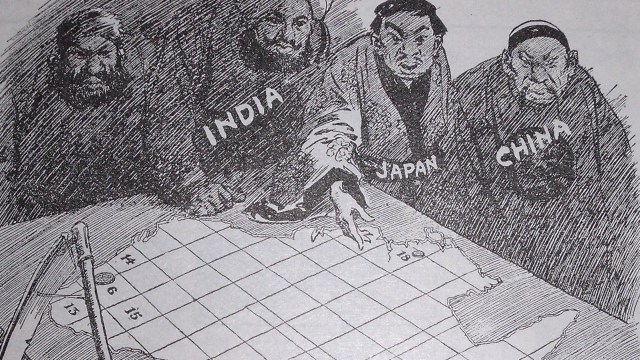382 – Two Eggs and a Kidney: Regional World Cities

This world map slices up the globe into two egg-shaped pieces and, for some reason, a kidney-shaped one. It purports to show the world’s three panregions (*), and the world cities with which they interact. In all, there are nine of these “regional world cities”: two “panregional centres”, three “major regional centres” and four “minor regional centres”.
The American panregion is divided into northern and southern halves, but both are dominated by northern cities: New York and Miami respectively.
The Euro-Afro-Middle-Eastern one (note: find snappier name for this panregion) is more complex, with a Francophone African subregion within Africa, and the Middle East seemingly straddling Africa and Europe. London has the biggest reach of all the regional world cities in this zone, interacting with Europe, the Middle East and Africa. But not with Francophone Africa, which is the sole domain of Paris. Johannesburg and Brussels are minor players, tentatively tentaculating into their respective continents.
The Asia-Oceania panregion is divided into four subregions: North East and South East Asia, Japan and Oceania. Singapore and Hong Kong are mirror images of each other, extending their influence into both subregions on their side of the north-south axis. Tokio is the main hub of the small Japanese zone.
The acronym GaWC refers to the Globalisation and World Cities Research Network (based at the Geography Department of Loughborough University in the UK), a network focused on studying the interaction between world cities (which obviously encompasses the study of globalisation).
A world city is a city with a global impact – and thus not necessarily synonymous with a megacity. Which is why Brussels (app. 1 million inhabitants, but lots of Eurocrats and lobbyists among them) is one, but much more populous cities like Lagos, Mexico City or Pyongyang aren’t.
“Global impact” naturally is a highly subjective term. Since 1998, the GaWC at Loughborough has tried to define and refine a set of criteria that world cities have to correspond to. I am guessing this map dates from the GaWC’s early days. More recent updates, in 2004 and 2008, have produced sophisticated rankings and subsets of world cities that go beyond just the nine of them on this map.
Nevertheless, in the 2008 update, London and New York are still listed as the only two world cities in the top, “Alpha++” category. The Alpha+ category is made up of Hong Kong, Paris, Singapore and Tokyo (also on this map), but also Sydney, Shanghai and Beijing. All the way down the list are “Gamma-” cities such as Edinburgh, Tallinn, San Diego, Calgary and Doha.
Many thanks to blgfk for sending in this map, taken here. More info on the GaWC on this page at Loughborough University.
* Since there’s three of them instead of two, it would be silly to call them hemispheres.





